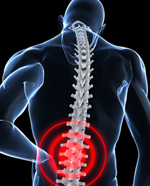 of the spinal structure and surrounding tissues the risk of creating instability is low.
of the spinal structure and surrounding tissues the risk of creating instability is low.
Hospitalization is only for one day and recovery period is short. Post operative pain is significantly reduced compared to the conventional laminectomy.
Procedure
Endoscopic lumbar decompression or discectomy is performed through a trocar which is conduit. Skin incision is app. 1 centimeter. The surgery is performed under endoscopic vision. Thanks to minimal disruption
Anatomy of the lumbar spine
The lumbar vertebra ( usually five ) form the spinal canal, where the spinal cord ends as “conus medullaris” at the level of L2. The nerve roots continue downward and form the “cauda equine” until they exit the spinal canal through the intervertebral foramen or hole on each side.
The role of the “conus medullaris” is mainly sphincter function, bladder and sex organs.
The number of the nerve root is determined by the level of the intervertebral disc ( L4 nerve root exits between L4 and L5 vertebra. Due to the anatomy of the lumbar spine L4-L5 disc herniation will more likely give L5 nerve root symptoms ).
Pathology of the lumbar spine (degenerative)
Degenerative spinal stenosis ( narrowing ) is typical of the elderly. It is caused by facets hypertrophy, thickened ligaments or disc protrusion and sometime by slippage of one vertebra over the other ( spondylolisthesis ).
Disc herniation is more typical of the young population but not exclusively.
Synovial cyst is a more rare condition.
Symptoms
A) Disc herniation can cause radicular shooting leg pain radiating from the buttock area (so called sciatica or sciatic pain); if symptoms progress there may be numbness and weakness (foot drop).
B) Spinal stenosis is the cause of "spinal claudication" with progressive difficult walking which improves by bending forward or sitting down.
C) L1-L2 level may cause "cauda equine" syndrome with sphincter incontinence and peri-anal numbness.
Indications for surgery
A) Radiculopathy with radiating leg pain that did not improve with conservative treatment.
B) Foot drop or other leg weakness.
C) Difficulty walking due to spinal stenosis
D) “Cauda equine” syndrome.
E) Appropriate MRI imaging ( CT myelogram for those who cannot obtain MRI ).






